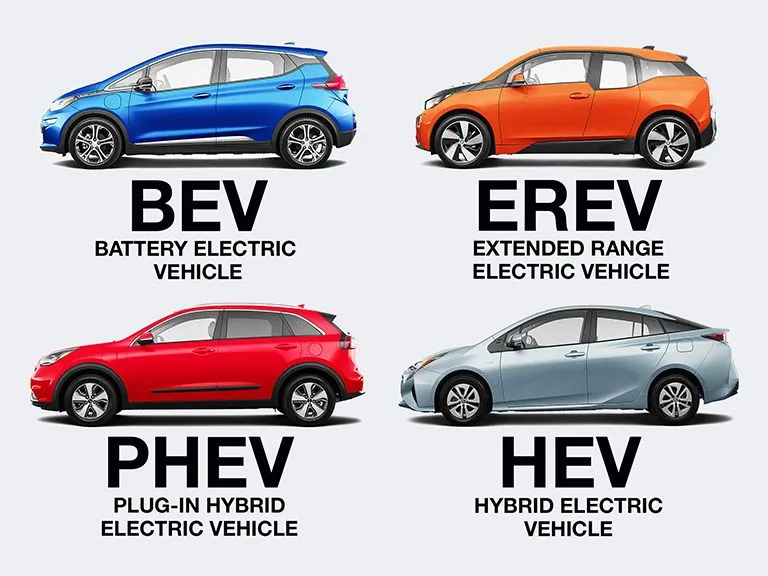
BEV, EREV, PHEV, HEV – What Do They Mean? Here's Your Electric Vehicle Dictionary
What's the difference between a Pure Electric, an Extended Range EV, a Plug-In Hybrid, and a Hybrid Electric Vehicle?
By John Coulter, Current EV CMO
A Pure Electric, or Battery-Powered Electric Vehicle (BEV) gets all its power from its batteries and electric motors. It contains no internal combustion engine (ICE). Its electric motor uses batteries that are recharged by plugging in to an electric power source (a wall socket or EV charger). An example is the Chevrolet Bolt. CO2 is emitted during the BEV's manufacturing process, however no CO2 is emitted by the BEV itself, once it begins operating. The grid sending power to charging stations the BEV uses to replenish its battery may emit CO2. (A coal-burning electricity-generating plant is an example.) But extensive studies have shown that from cradle to grave, EVs emit 50 to 51% LESS CO2 than ICE vehicles– and this equation includes the emissions created by recharging the BEV's battery from the grid.
For much more extensive information about how clean BEVs are and how they create 50 to 51% less CO2, read the article on this blog: EVs: Cleaner Cars from Cradle to Grave – Definitive Proof from the UCS (Union of Concerned Scientists)
An Extended Range Electric Vehicle (EREV) has an auxiliary power unit (called a range extender) which increases the EREV’s driving range. Most range extenders are small internal combustion engines that drive an electric generator furnishing the electric batteries and motor with electricity. An EREV will create CO2 when its small range extender motor is operating, but not when the EREV is using its electric power. Over its lifetime, an EREV will create significantly less CO2 than an ICE car. An example of an EREV is the Extended Range BMW i3.
A Plug-In Hybrid Electric Vehicle (PHEV) or Plug-In Hybrid, uses an electric motor and gas engine to operate. Its electric motor uses batteries that are recharged by plugging in to an electric power source (a wall socket or EV charger). The gas-powered motor can work together with the electric motor, or separately on its own, to power the powertrain. Extensive scientific studies have shown that powertrains using a gas engine plus an electric motor (or, in many cases, 2 or 3 electric motors), creates much better fuel efficiency. Less fuel is burned during the PHEV's operation, reducing greenhouse gas output. An example of a PHEV is the Kia Niro Plug-In Hybrid.
A Hybrid Electric Vehicle (HEV) is a type of hybrid vehicle and electric vehicle that combines a conventional internal combustion engine (ICE) propulsion system with an electric propulsion system (hybrid vehicle drivetrain). The presence of the electric powertrain is intended to achieve better fuel economy and performance. The best example of HEV efficiency is the Toyota Prius Hybrid, which gets the best gas mileage (between 50 and 60mph) of any car using an internal combustion engine.
A Fuel Cell Electric Vehicle (FCEV) generates electricity to power the motor, generally using oxygen form the air and compressed hydrogen. Most Fuel Cell Vehicles are classified as ZEVs: Zero Emission Vehicles that emit only water and heat.
Not to make things difficult, but the BEV, EREV, PHEV, HEV, and even the FCEV are all considered Electric Vehicles.
An Internal combustion engine (ICE) is a heat engine where the combustion of fuel occurs with an oxidizer (usually air) in a combustion chamber. The expansion of high-temperature and high-pressure gases produced by the mini explosion applies direct force to turbine blades, rotors, or as in the case with almost all cars, to pistons. The rotating pistons drive the car's crankshaft, which turns the wheels. providing motion. When gas (or diesel fuel) is burned, the combusted material remaining is toxic gas, which pollutes the environment.
NEV: New electric vehicle (BEV & PHEV)
PEV: Plug-in electric vehicle (BEV & PHEV)
Recent Posts
- The 2022 Audi Q4 e-Tron SUV combines performance, practicality and luxury
- Ford's 2022 F150 Lightning All-Electric Truck is in high demand
- Legendary Audi performance is at the heart of the 2022 Audi e-tron GT and its RS sibling.
- Meet the Lexus RZ 450e – the luxury brand’s 1st EV
- The 2022 GV60 is Genesis’ first all-electric vehicle

